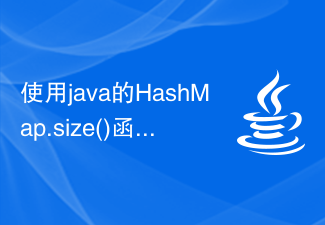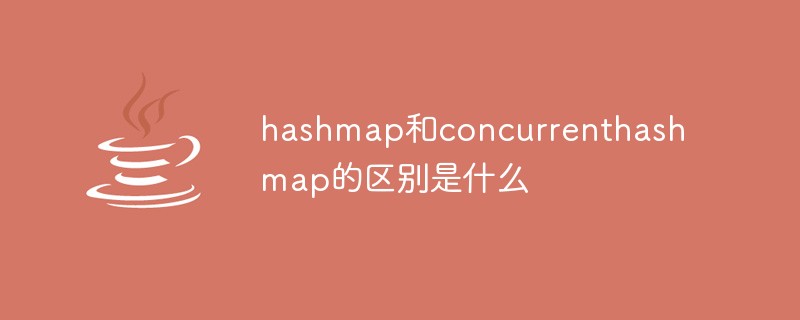Found a total of 51 related content

Is there hashmap in javascript?
Article Introduction:There is hashmap in javascript, and the method to implement hashmap is "function HashMap(){this.map = {};}HashMap.prototype = {put: function...}".
2021-11-18comment 03085

How to insert key-value pairs into HashMap using put() method of HashMap class
Article Introduction:How to insert key-value pairs into a HashMap using the put() method of the HashMap class. HashMap is a very important class in the Java collection framework. It provides a way to store key-value pairs. In actual development, we often need to insert key-value pairs into HashMap, which can be easily achieved by using the put() method of the HashMap class. The signature of HashMap's put() method is as follows: Vput(Kkey,Vvalue)
2023-07-26comment 0722

How to implement hashmap in php
Article Introduction:How to implement hashmap in PHP: Use the [construct()] constructor to implement it, and the code is [Class HashMap{var $H_table; public function __construct(){$this->H_table = a}].
2020-09-28comment 04107

Can Java HashMap key be repeated?
Article Introduction:Keys in Java's HashMap cannot be repeated. If added repeatedly, HashMap will automatically overwrite the data with the same key, ensuring that one key corresponds to one value. When using it, just add the data in one HashMap to another HashMap in sequence according to the key. That’s it.
2020-06-01comment 05283

How to implement hashmap in golang
Article Introduction:The map structure that comes with the golang language is a very convenient data type, but for more efficient and flexible data operations, we can choose to use the hashmap implemented by golang. This article will introduce how golang implements hashmap. 1. Implementation Principle The principle of golang implementing hashmap is very simple, which is to map key-value pairs to an array through a certain algorithm, and use a linked list to resolve hash conflicts. Specifically, implementing hashmap requires the following steps: 1. Create a number
2023-04-03comment 0594

What is the difference between LinkedHashMap and HashMap in java
Article Introduction:1. Explain that Map can basically use HashMap, but HashMap has a problem, that is, the order of iterating HashMap is not the order in which HashMap is placed, or it is out of order. This shortcoming of HashMap often causes trouble, because in some scenarios we expect an ordered Map, which is LinkedHashMap. 2. Difference instances publicstaticvoidmain(String[]args){Mapmap=newLinkedHashMap();map.put("apple","Apple");map.put("
2023-05-02comment 0722

How does HashMap work?
Article Introduction:This article comes from the Java Quick Start column. It analyzes the working principle of hashmap in detail. I hope it can help you. HashMap is implemented based on the Hash algorithm. HashMap will obtain the hash value of the key based on the key.hashCode() method.
2020-02-11comment 02561

Use java's HashMap.size() function to get the size of a HashMap
Article Introduction:Use java's HashMap.size() function to get the size of a HashMap. In Java, HashMap is a commonly used collection class that is used to store key-value pairs. HashMap provides a series of convenient methods to operate on the elements in the collection, one of which is the size() function, which is used to obtain the number of elements in the HashMap. In this article, we will introduce how to use the size() function of HashMap to obtain the size of a HashMap, and provide code examples. first
2023-07-25comment 01307

Interpretation of Java documentation: Detailed explanation of the usage of clear() method of HashMap class
Article Introduction:Interpretation of Java documentation: Detailed explanation of the usage of the clear() method of the HashMap class. HashMap is one of the commonly used data structures in the Java collection framework and is used to store key-value pairs. The clear() method is a method in the HashMap class, used to clear all key-value pairs in the HashMap. This article will explain the usage of HashMap's clear() method in detail and provide specific code examples. 1. Method introduction In the HashMap class, the clear() method is declared as follows
2023-11-04comment 0245

Interpretation of Java documentation: Detailed explanation of the usage of the values() method of the HashMap class
Article Introduction:Interpretation of Java documentation: Detailed explanation of the usage of the values() method of the HashMap class. The HashMap class is one of the commonly used data structures in Java. It provides a storage method of key-value pairs. In actual development, we often encounter scenarios where we need to obtain all values in HashMap. The values() method of the HashMap class is the method used to return all the values in the HashMap. This article will analyze the usage of the values() method of the HashMap class in detail and give instructions.
2023-11-04comment 0649

What is the difference between hashmap and concurrenthashmap
Article Introduction:Difference: HashMap is thread-unsafe. When multi-threaded operations occur, security risks may arise; ConcurrentHashMap is thread-safe. HashMap does not support concurrent operations and has no synchronization method; ConcurrentHashMap supports concurrent operations.
2021-02-02comment 010622

Use java's HashMap.put() function to add mapping relationships to HashMap
Article Introduction:Title: Add mapping relationships to HashMap using Java's HashMap.put() function Introduction: In Java programming, using HashMap is very common and important. HashMap is a collection of key-value pairs that can store and retrieve data. This article will focus on how to use Java's HashMap.put() function to add a mapping relationship to a HashMap, and illustrate it with code examples. Introduction to HashMap HashMap is based on hashing
2023-07-24comment 0993

Use java's HashMap.get() function to get elements in a HashMap
Article Introduction:Use Java's HashMap.get() function to obtain elements in a HashMap. HashMap is one of the commonly used data structures in Java. It is used to store the mapping relationship of key-value pairs. In the actual development process, it is often necessary to obtain specific elements from HashMap. The HashMap class provides the get() method, allowing us to obtain the corresponding value through the key. This article will introduce in detail how to use the get() function of HashMap and provide corresponding code examples. HashM
2023-07-25comment 0670

How to implement HashMap, LinkedHashMap and TreeMap in JShell in Java 9?
Article Introduction:JShell is a command line prompt tool introduced in Java 9, also known as the REPL tool that evaluates a simple statement, executes it and prints the output immediately. The Map interface specifies a contract that implements collection pairs of elements in key/value form. Java collection classes that implement the Map interface include HashMap, LinkedHashMap and TreeMap. In the code snippet below, the elements of the HashMap are not guaranteed to be stored in insertion order or the sorted order of the keys. Snippet-1jshell>HashMaphashMap=newHashMap<>();hashMap==&
2023-09-12comment 0862

Interpretation of Java documentation: Detailed explanation of the usage of the size() method of the HashMap class
Article Introduction:Interpretation of Java documentation: Detailed explanation of the usage of the size() method of the HashMap class. Specific code examples are required. In Java, HashMap is a commonly used data structure that provides a way to store key-value pairs. The size() method of the HashMap class is used to return the number of key-value pairs in the HashMap. Specific code examples are as follows: importjava.util.HashMap;publicclassHashMapSizeExamp
2023-11-04comment 0194

Use java's HashMap.clear() function to delete all elements in the HashMap
Article Introduction:Use Java's HashMap.clear() function to delete all elements in the HashMap. During the development process of Java, we often use the HashMap class to store and manage a series of key-value pair data. When we need to delete all elements in a HashMap, we can use the clear() function of HashMap. This article will introduce how to use the HashMap.clear() function and give corresponding code examples. HashMap is Java
2023-07-24comment 0745

Implementation principle of hashmap in java
Article Introduction:HashMap is implemented using a hash table and maps keys to slots through hash functions to achieve fast access. Conflict handling uses techniques such as zippers, open addressing, and buckets. The load factor controls the ratio of the number of elements to the number of buckets. If it is too high, conflicts will increase. HashMap will automatically expand to reduce conflicts. It is not thread-safe by default and requires using ConcurrentHashMap instead.
2024-05-08comment 0404

Java uses the get() function of the HashMap class to obtain the values in the collection
Article Introduction:Java uses the get() function of the HashMap class to obtain the values in the collection. HashMap is one of the commonly used collection classes in Java. It provides a storage method of key-value pairs that can quickly obtain values by key. In HashMap, we can use the get() function to obtain the value corresponding to the specified key. This article will introduce how to use the get() function of HashMap and provide some usage examples. First, we need to import the package where the HashMap class is located: importjav
2023-07-24comment 0598

How to use HashMap function for mapping operations in Java
Article Introduction:The HashMap function is a very commonly used mapping function in Java, which allows us to store and access data in the form of key-value pairs. This article will introduce how to use the HashMap function for mapping operations. First, we need to understand what the HashMap function is. HashMap is a hash table data structure in Java that implements the Map interface. It allows us to store key-value pairs and retrieve the corresponding value by key. HashMap converts the key into an index through a hash function and stores the value in
2023-06-26comment 01032

What is the difference between treemap and hashmap in java?
Article Introduction:Differences: 1. The elements in HashMap have no order; all elements in TreeMap have a certain fixed order. 2. HashMap inherits the AbstractMap class and is implemented based on the hash table; TreeMap inherits the SortedMap class and is implemented based on the red-black tree.
2020-11-11comment 030632
















